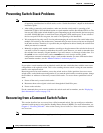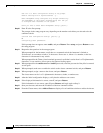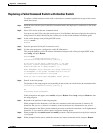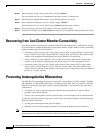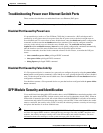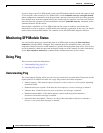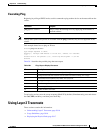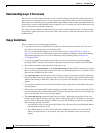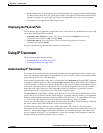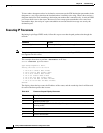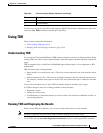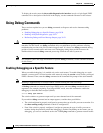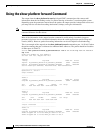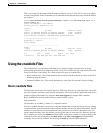
38-16
Catalyst 2960 and 2960-S Switch Software Configuration Guide
OL-8603-09
Chapter 38 Troubleshooting
Using Layer 2 Traceroute
Understanding Layer 2 Traceroute
The Layer 2 traceroute feature allows the switch to identify the physical path that a packet takes from a
source device to a destination device. Layer 2 traceroute supports only unicast source and destination
MAC addresses. It finds the path by using the MAC address tables of the switches in the path. When the
switch detects a device in the path that does not support Layer 2 traceroute, the switch continues to send
Layer 2 trace queries and lets them time out.
The switch can only identify the path from the source device to the destination device. It cannot identify
the path that a packet takes from source host to the source device or from the destination device to the
destination host.
Usage Guidelines
These are the Layer 2 traceroute usage guidelines:
• Cisco Discovery Protocol (CDP) must be enabled on all the devices in the network. For Layer 2
traceroute to function properly, do not disable CDP.
For a list of switches that support Layer 2 traceroute, see the “Usage Guidelines” section on
page 38-16. If any devices in the physical path are transparent to CDP, the switch cannot identify
the path through these devices. For more information about enabling CDP, see Chapter 25,
“Configuring CDP.”
• A switch is reachable from another switch when you can test connectivity by using the ping
privileged EXEC command. All switches in the physical path must be reachable from each other.
• The maximum number of hops identified in the path is ten.
• You can enter the traceroute mac or the traceroute mac ip privileged EXEC command on a switch
that is not in the physical path from the source device to the destination device. All switches in the
path must be reachable from this switch.
• The traceroute mac command output shows the Layer 2 path only when the specified source and
destination MAC addresses belong to the same VLAN. If you specify source and destination MAC
addresses that belong to different VLANs, the Layer 2 path is not identified, and an error message
appears.
• If you specify a multicast source or destination MAC address, the path is not identified, and an error
message appears.
• If the source or destination MAC address belongs to multiple VLANs, you must specify the VLAN
to which both the source and destination MAC addresses belong. If the VLAN is not specified, the
path is not identified, and an error message appears.
• The traceroute mac ip command output shows the Layer 2 path when the specified source and
destination IP addresses belong to the same subnet. When you specify the IP addresses, the switch
uses the Address Resolution Protocol (ARP) to associate the IP addresses with the corresponding
MAC addresses and the VLAN IDs.
–
If an ARP entry exists for the specified IP address, the switch uses the associated MAC address
and identifies the physical path.
–
If an ARP entry does not exist, the switch sends an ARP query and tries to resolve the IP
address. If the IP address is not resolved, the path is not identified, and an error message
appears.



